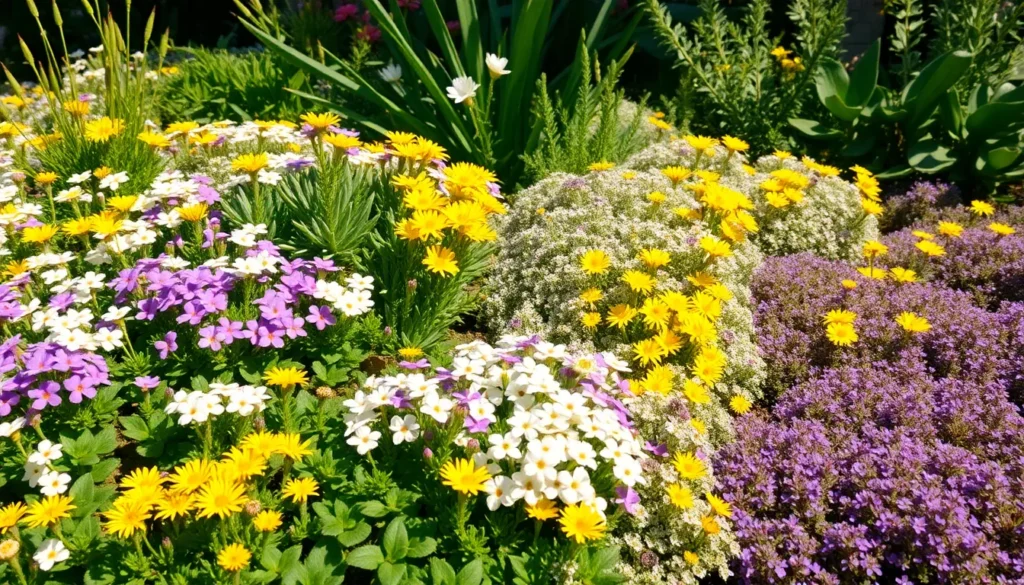Transforming your sun-soaked industry doesn’t have to mean endless hours of maintenance or sky-high water bills. We’ve discovered that the right ground cover plants can turn those challenging sunny spots into stunning, low-maintenance garden features that practically care for themselves.
Whether you’re dealing with a steep slope that’s impossible to mow, bare patches where grass won’t grow, or simply want to add texture and color to your industry, sun-loving ground covers offer the perfect solution. These hardy performers thrive in full sunlight while suppressing weeds, preventing soil erosion, and creating beautiful living carpets that last season after season.
We’ll guide you through the best ground cover options for sunny areas – from drought-tolerant succulents to flowering perennials that’ll have your neighbors asking for your secret. Get ready to discover how these powerhouse plants can revolutionize your outdoor space with minimal effort and maximum impact.
Choose Low-Maintenance Creeping Phlox for Vibrant Spring Color
Creeping phlox stands out as one of our top recommendations for sunny ground cover that delivers spectacular spring blooms with minimal upkeep. This hardy perennial creates stunning carpets of colorful flowers that transform bare patches into vibrant displays.
Plant Care Requirements and Growing Conditions
Soil needs for creeping phlox are surprisingly simple, as this adaptable plant thrives in well-draining soil with a pH between 6.0 and 8.0. Sandy or rocky soils work exceptionally well, making it perfect for challenging areas where other plants struggle.
Watering requirements remain minimal once established, typically needing only 1 inch of water per week during the growing season. Deep, infrequent watering encourages stronger root development compared to frequent shallow watering.
Sunlight exposure should provide at least 6 hours of direct sunlight daily for optimal flowering performance. Partial shade locations can work but may result in reduced bloom density and leggy growth patterns.
Temperature tolerance ranges from USDA zones 3 through 9, withstanding winter temperatures as low as -40°F. Heat tolerance allows successful cultivation in areas with summer temperatures reaching 90°F or higher.
Maintenance tasks include light pruning after flowering to maintain shape and promote denser growth. Annual fertilization with a balanced 10-10-10 fertilizer in early spring supports healthy development.
Best Varieties for Full Sun Exposure
Phlox subulata ‘Candy Stripe’ produces white flowers with pink centers, spreading 12 to 18 inches wide while reaching 4 to 6 inches in height. This variety blooms from April through May and tolerates drought conditions exceptionally well.
Phlox subulata ‘Emerald Cushion Blue’ offers lavender-blue flowers that create striking contrasts against its evergreen foliage. Growth habits include spreading 12 to 15 inches with a compact 3 to 4 inch height profile.
Phlox subulata ‘Red Wings’ displays vibrant crimson-red blooms that maintain their intensity throughout the flowering period. Spreading characteristics reach 18 to 24 inches while maintaining a low 4 to 5 inch height.
Phlox subulata ‘White Delight’ produces pure white flowers that brighten shaded corners and complement other colorful plantings. Mature size reaches 12 to 18 inches in spread with a 3 to 4 inch height profile.
Phlox subulata ‘Purple Beauty’ showcases deep purple flowers with darker centers, creating dramatic visual impact in rock gardens and borders. Growth patterns include 15 to 20 inch spreads with consistent 4 to 6 inch heights.
Select Sedum Varieties for Drought-Tolerant Ground Coverage
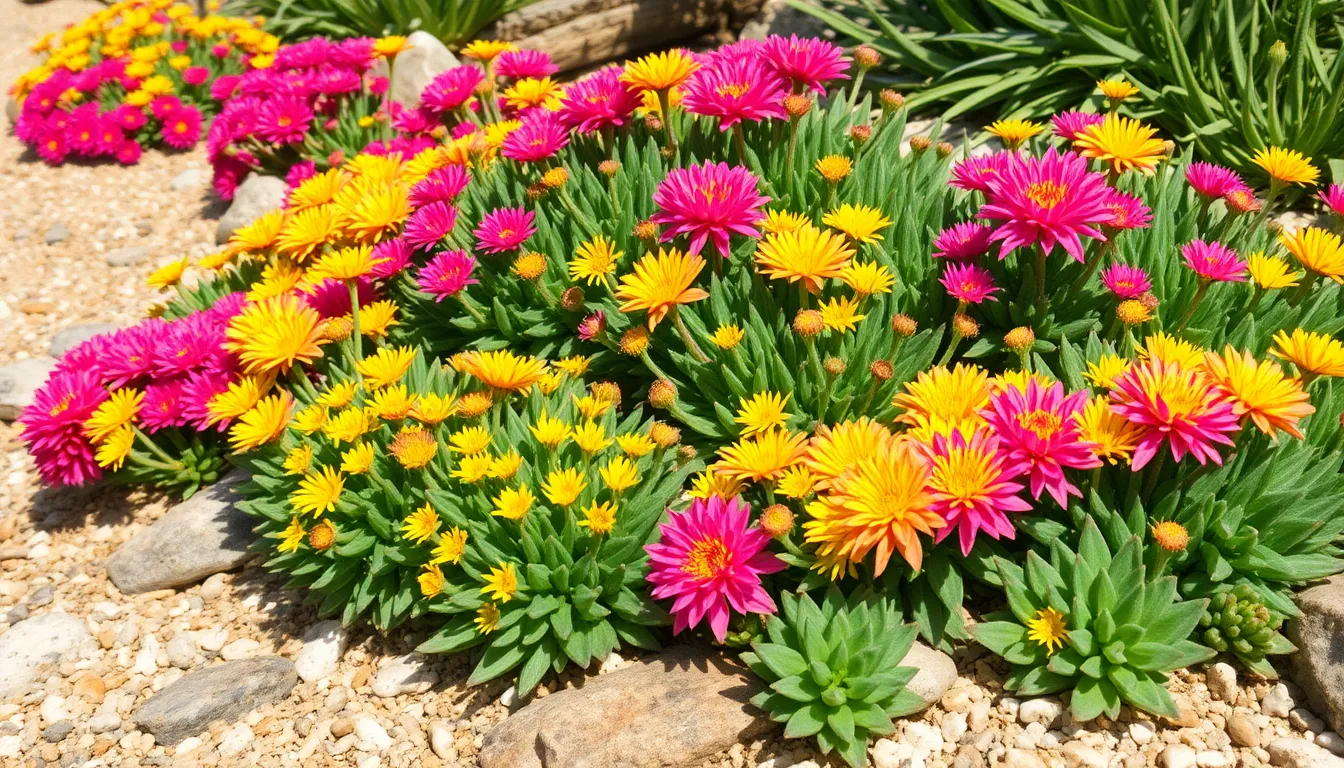
Sedum stands out as one of the most resilient ground cover options for sunny locations due to its exceptional drought tolerance and water-storing succulent leaves. These hardy plants thrive in full sun exposure and require minimal watering once established, making them perfect for xeriscaping projects or low-maintenance garden designs.
Popular Sedum Types for Sunny Areas
Sedum acre creates a thick, fast-spreading carpet that rapidly fills empty spaces in sunny garden beds. This variety grows low to the ground and produces bright yellow flowers during summer months while maintaining its evergreen or semi-evergreen foliage throughout most of the growing season. We recommend this type for areas where quick coverage is essential since it establishes rapidly in well-draining sandy or rocky soils.
Sedum ‘Dragon’s Blood’ offers striking visual appeal with its vibrant red foliage and delicate pink star-shaped flowers. This variety adds both color and texture to sunny landscapes while providing the same drought-tolerant benefits as other sedum types. Its compact growth habit makes it ideal for borders, rock gardens, or areas between stepping stones where moderate foot traffic occurs.
Both varieties excel in well-draining conditions and tolerate various soil types including sandy, rocky, or even clay soils as long as proper drainage exists. These plants demonstrate excellent deer resistance and require virtually no maintenance once established in appropriate growing conditions.
Seasonal Color Changes and Bloom Times
Spring and summer blooming periods bring clusters of small star-shaped flowers to sedum ground covers, with colors ranging from bright yellow to soft pink or vibrant red depending on the exact variety. Sedum acre typically produces its cheerful yellow blooms during summer months, creating a sunny carpet effect across garden beds.
Seasonal foliage transformations provide year-round visual interest beyond the flowering periods. Sedum ‘Dragon’s Blood’ deepens its red coloration during cooler weather, intensifying from spring’s lighter tones to autumn’s rich burgundy hues. This color progression adds ever-changing seasonal appeal that continues well after the pink flowers fade.
Extended growing season benefits make sedums valuable for maintaining garden color from spring through fall. Their succulent leaves retain attractive appearances throughout most of the year, providing consistent ground coverage when other plants enter dormancy periods.
Plant Creeping Thyme for Fragrant and Walkable Ground Cover
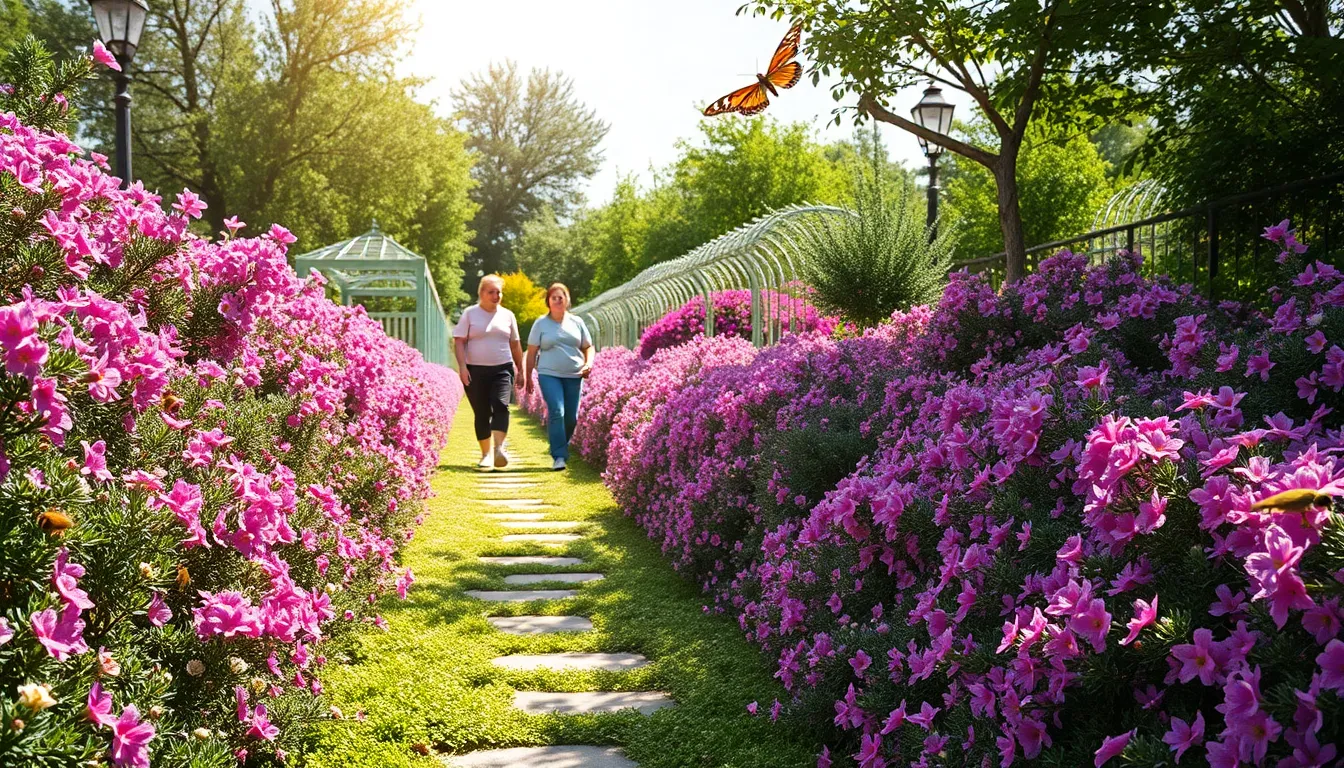
Creeping thyme offers something truly special among sun loving ground covers: it releases a delightful herbal scent when you walk across it. This versatile plant forms dense, low mats that can handle light to moderate foot traffic while thriving in full sun and well-drained soils.
Culinary and Ornamental Thyme Options
Culinary thyme varieties provide dual purpose benefits for your sunny garden spaces. These aromatic cultivars offer fragrant leaves perfect for seasoning dishes while creating attractive ground coverage between pavers or along garden pathways.
Ornamental thyme varieties focus primarily on visual appeal with stunning flower displays. Blooms appear in shades of pink, purple, or white throughout the growing season, attracting beneficial pollinators like bees and butterflies to your garden.
Both types maintain the characteristic drought tolerance once established, making them excellent choices for low maintenance landscaping. The aromatic foliage releases pleasant scents when brushed against or stepped on, adding sensory appeal to outdoor living spaces.
Establishing Thyme in High-Traffic Areas
Site preparation requires well-drained soil and full sun exposure for optimal thyme growth. We recommend testing your soil drainage by digging a small hole and filling it with water to ensure it drains within a few hours.
Planting spacing should be 6 to 12 inches apart for quick ground coverage establishment. Closer spacing creates faster coverage but requires more initial investment in plants, while wider spacing takes longer to fill in completely.
Watering needs change significantly after establishment, starting with moderate irrigation during the first growing season. Once mature, thyme becomes highly drought resistant and actually performs better with minimal supplemental watering.
Traffic considerations matter most for long term success in walkable areas. Light to moderate foot traffic enhances the fragrant experience without damaging the plants, but heavy or constant traffic can cause permanent damage to the delicate stems and foliage.
Consider Ajuga for Dense Coverage in Challenging Spots
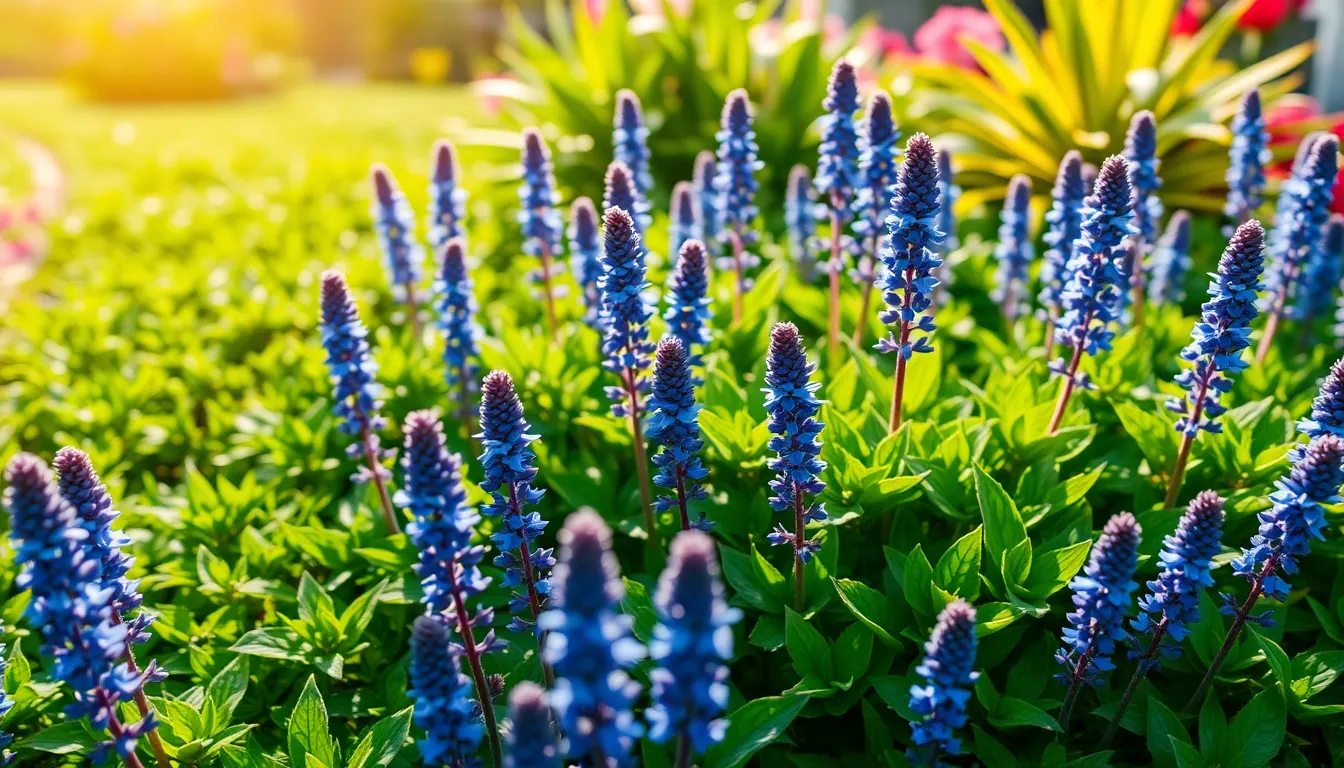
Ajuga, commonly known as bugleweed (Ajuga reptans), offers exceptional ground cover answers for those difficult sunny spots where other plants struggle to establish. We’ve found this fast-growing perennial forms dense mats that effectively suppress weeds while creating attractive living carpets with striking blue flower spikes.
Shade Tolerance and Adaptability Benefits
Versatility makes Ajuga stand out among sun-loving ground covers since it thrives in full sun yet tolerates partial shade conditions. Gardens with varying light patterns throughout the day benefit from this adaptability, allowing consistent coverage across different zones. Soil flexibility adds another advantage as Ajuga grows successfully in various soil types and challenging conditions where other ground covers might fail.
Establishment occurs quickly in sunny locations, with plants spreading to form thick coverage that prevents soil erosion effectively. Weather tolerance extends Ajuga’s usefulness across different climate zones, making it reliable for long-term landscaping answers. Visual appeal comes from the attractive foliage that maintains interest beyond the blooming season, complementing other sun-loving plants like creeping thyme and sedum varieties.
Controlling Ajuga’s Spreading Tendency
Spreading happens through creeping stolons, which are above-ground runners that enable rapid ground coverage but require management to prevent invasive growth. We recommend monitoring Ajuga’s expansion regularly and dividing plants periodically to maintain desired boundaries. Barrier edging provides effective containment, keeping the growth within designated areas without compromising the plant’s natural spreading benefits.
Maintenance includes thinning overcrowded sections to prevent Ajuga from overwhelming neighboring plants or garden spaces. Division every 2-3 years helps control density while providing new plants for other areas of your industry. Strategic placement away from delicate perennials ensures Ajuga’s vigorous growth doesn’t interfere with less aggressive plant varieties in your sunny ground cover design.
Install Pachysandra for Evergreen Year-Round Appeal
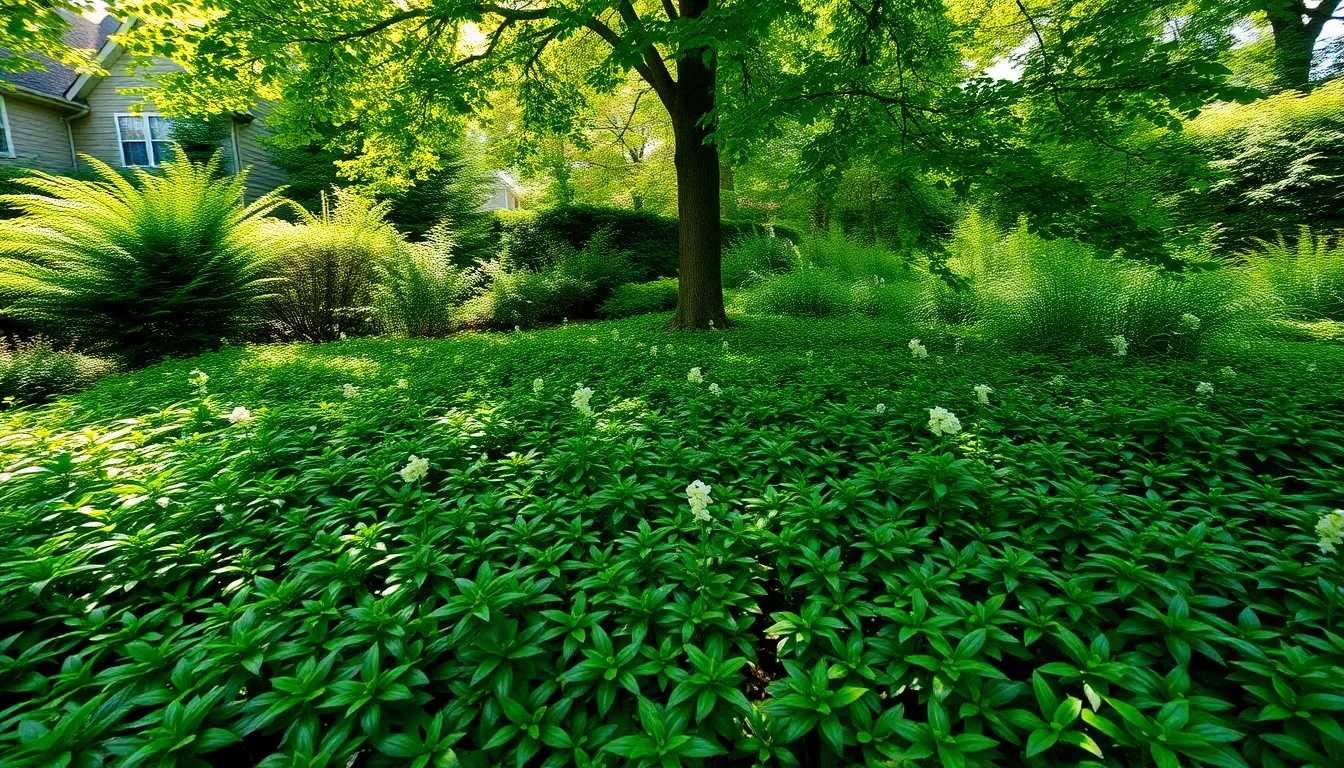
Pachysandra brings consistent greenery to your garden industry throughout all seasons with its dense evergreen foliage. This reliable ground cover creates a lush carpet effect that maintains visual interest even when other plants go dormant during winter months.
Maintenance Tips for Healthy Growth
Establish proper soil drainage to prevent root rot and ensure your pachysandra thrives in its new location. We recommend testing soil drainage by digging a small hole and filling it with water to see how quickly it absorbs.
Water regularly during the establishment period, then reduce frequency once the plants develop strong root systems. Most pachysandra varieties become moderately drought tolerant after their first growing season.
Trim back growth in early spring to remove any damaged or old foliage and encourage fresh shoots. This annual pruning keeps the ground cover looking dense and healthy.
Clear weeds around newly planted pachysandra to reduce competition for nutrients and water. Maintaining a weed free zone helps young plants establish more quickly.
Apply a 2 to 3 inch layer of organic mulch around plants to retain soil moisture and suppress unwanted weeds. Mulching also provides additional nutrients as it breaks down over time.
Feed with balanced fertilizer once annually in early spring to support sustained growth throughout the growing season. A slow release granular fertilizer works best for consistent nutrient delivery.
Companion Planting Strategies
Combine pachysandra with shade tolerant shrubs and perennials that complement its evergreen nature without competing for space. Plants like hostas, ferns, and astilbe create beautiful textural contrasts while sharing similar growing conditions.
Place taller companion plants strategically to provide dappled shade for pachysandra in areas with intense afternoon sun. This protective canopy helps prevent leaf scorch while maintaining the plant’s preferred light conditions.
Select plants with different bloom times to extend seasonal interest beyond pachysandra’s subtle spring flowers. Early spring bulbs like snowdrops and crocuses emerge before pachysandra fills in completely.
Avoid aggressive spreading plants that might overwhelm pachysandra’s steady but slower growth rate. Fast spreading groundcovers can quickly dominate and reduce the evergreen appeal you’re working to establish.
Space companion plantings appropriately to allow pachysandra room to spread naturally over time. Proper spacing prevents overcrowding while creating a harmonious garden design that showcases each plant’s unique characteristics.
Choose Vinca Minor for Slopes and Banks
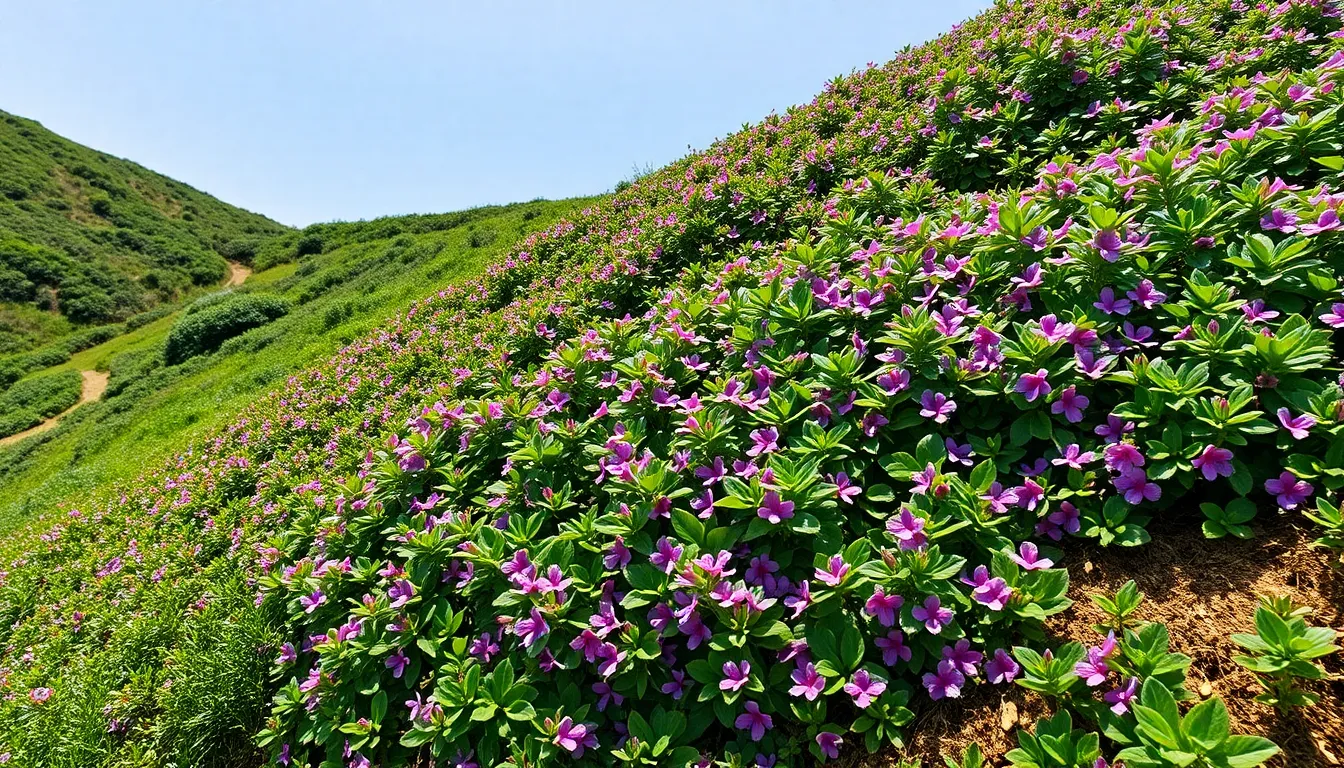
Vinca minor stands out as our top choice for stabilizing challenging sunny slopes and banks. This periwinkle creates dense, mat-forming coverage that transforms difficult terrain into attractive, low-maintenance landscapes.
Erosion Control Benefits
Vinca minor’s extensive root system binds soil effectively, preventing washout during heavy rainfall events. We’ve observed how this natural erosion control maintains soil structure on slopes while reducing runoff that can damage nearby landscapes or structures. The plant acts as a living mulch that shades soil surfaces, keeping them cool and damp to further prevent wind and water erosion.
Dense foliage coverage suppresses weeds by blocking sunlight that reaches the ground beneath its leaves. This weed suppression reduces competition for soil nutrients and water, allowing the vinca to establish stronger root systems. Our experience shows that established vinca minor creates such thick coverage that maintenance becomes minimal after the first growing season.
Soil moisture conservation occurs naturally as the plant’s canopy reduces evaporation rates. Temperature stability improves beneath the foliage, protecting soil organisms and root systems from extreme heat fluctuations. Banks and slopes benefit from this microclimate creation, which supports overall soil health and plant establishment.
Managing Aggressive Spreading Habits
Vinca minor’s fast spreading nature requires careful monitoring to prevent it from overtaking native plants or desired garden areas. We recommend installing physical barriers like edging or trenches around planting areas to contain its growth within designated boundaries. Regular inspection allows us to catch unwanted spread before it becomes problematic.
Trimming back runners and shoots helps control expansion while maintaining the plant’s dense coverage in target areas. Our management approach includes cutting back excess growth twice per year, typically in spring and fall. This pruning prevents the plant from encroaching on other industry features or natural habitats.
Strategic placement away from sensitive native plant communities protects local ecosystems from potential invasion. We suggest maintaining buffer zones between vinca plantings and woodland edges or natural areas. Proper site selection ensures that the plant’s aggressive nature becomes an asset rather than a liability for slope stabilization projects.
Plant Lamb’s Ear for Silvery Texture and Interest
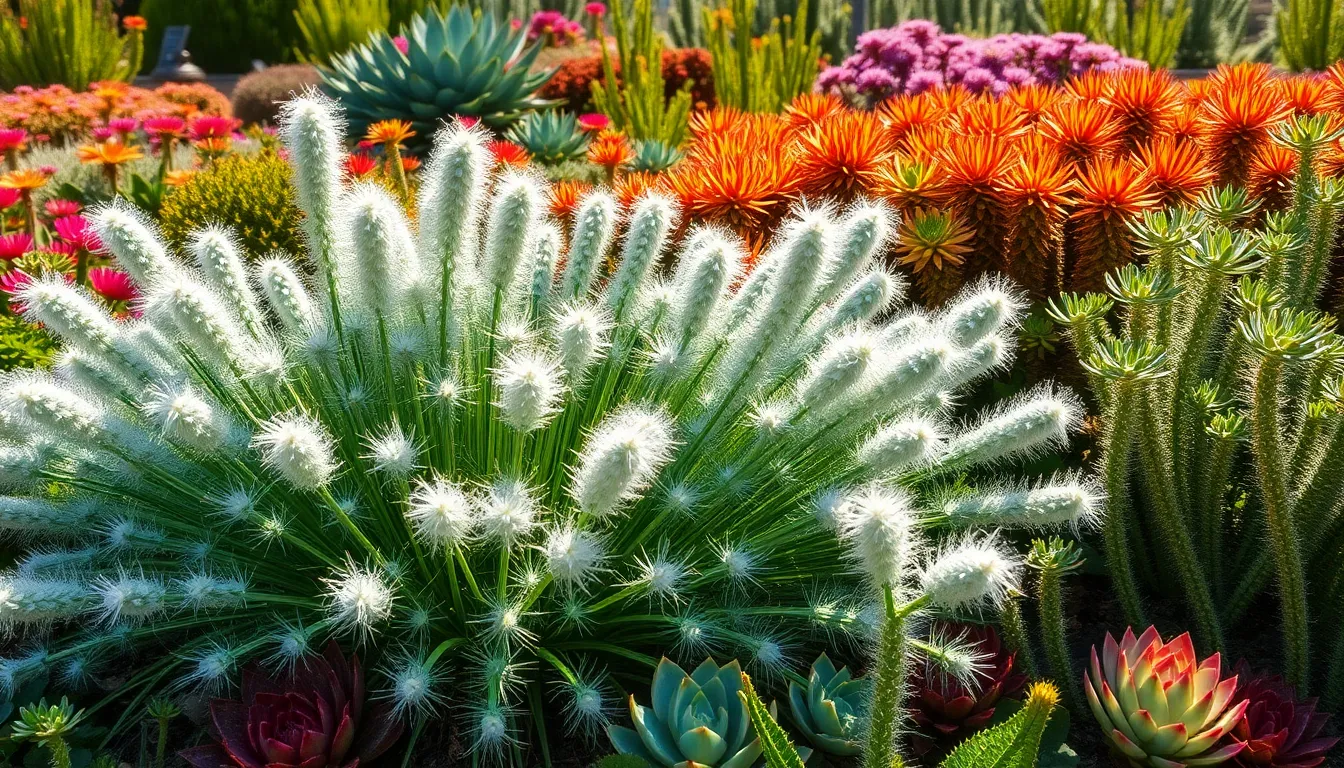
Lamb’s Ear (Stachys byzantina) transforms sunny garden spaces with its distinctive soft, silvery-green woolly leaves that create striking visual contrast alongside darker or more colorful plants. We recommend this versatile ground cover for its ability to brighten full sun areas while adding unique textural interest to garden beds.
Drought Resistance and Soil Requirements
Exceptional drought tolerance makes Lamb’s Ear perfect for sunny, dry locations where other plants struggle to survive. Once established, this resilient ground cover requires minimal watering and effectively tolerates heat and extended dry spells. Well-drained soil remains the most critical requirement for success, though Lamb’s Ear adapts to poor soil conditions as long as drainage stays adequate.
Moderately fertile soil provides optimal growing conditions, but we’ve found this adaptable plant thrives even in challenging sites. Poor drainage causes more problems than poor nutrition, so we always prioritize soil amendment for water movement over fertilization. Sandy or rocky soils often work better than clay-heavy ground that retains moisture.
Stonecrop varieties (Sedum spp.) complement Lamb’s Ear beautifully in sun-exposed gardens, offering colorful blooms alongside similar drought tolerance. These succulent ground covers handle hot, dry conditions with ease and create ever-changing plant combinations when paired with Lamb’s Ear’s silvery foliage.
Pruning and Deadheading Techniques
Late spring to early summer pruning keeps Lamb’s Ear looking its best by removing old or damaged foliage that detracts from the plant’s neat appearance. Shearing back tired growth encourages fresh, vigorous leaves and maintains the compact form that makes this ground cover so attractive.
Deadheading spent flowers extends the blooming period while preventing excessive self-seeding that can lead to overcrowding. We remove faded flower stalks promptly to redirect the plant’s energy into producing healthy foliage rather than seeds.
Prompt removal of yellow or diseased leaves reduces fungal infection risks, particularly important in humid climates where moisture-related problems develop quickly. Regular inspection helps us catch problems early before they spread throughout the planting.
Post-flowering pruning benefits stonecrop and other succulent ground covers by rejuvenating plants and maintaining compact shapes. This technique works well for mixed plantings that combine Lamb’s Ear with colorful sedum varieties for extended seasonal interest.
Select Ice Plant for Extreme Heat and Drought Conditions

Ice plants stand out as exceptional ground covers for the harshest sunny conditions where other plants struggle to survive. These succulent varieties store water in their thick leaves, making them perfect choices for areas with extreme heat and minimal irrigation.
Colorful Bloom Displays in Summer
Brilliant flower displays transform ice plant ground covers into stunning summer spectacles. Sedum varieties produce masses of star-shaped blooms in vibrant yellows, pinks, and reds that attract pollinators throughout the growing season. These colorful displays typically last from June through August, creating eye-catching carpets of color that require no additional water or care.
Timing varies by exact variety, with some ice plants like Sedum spurium blooming earlier in summer while others extend their flowering period into early fall. Peak blooming occurs during the hottest months when most other ground covers fade or require extra watering. The succulent nature of these plants ensures consistent blooming even during drought conditions, making them reliable performers for summer color.
Multiple flower colors can be combined to create ever-changing patterns across sunny slopes and garden beds. Popular combinations include pairing yellow flowering sedums with red or pink varieties to create striking contrasts that enhance visual appeal throughout summer months.
Winter Care in Cold Climates
Evergreen and semi-evergreen ice plant varieties provide year-round structure in cold climate gardens with minimal winter maintenance required. Sedum spurium and similar hardy varieties maintain their attractive foliage through winter months, offering continuous ground coverage when other plants die back. These resilient plants typically survive temperatures down to USDA Zone 3 without protection.
Mulching around established plants helps protect root systems during extreme cold snaps, though most ice plant varieties require little additional winter care once mature. We recommend applying a thin layer of organic mulch in late fall for newly planted areas or in regions with severe winter conditions.
Root protection becomes more critical than foliage care since ice plants naturally slow their growth during winter months. Well-draining soil prevents winter damage from freeze-thaw cycles that can harm plants with poor drainage. Avoiding winter watering allows plants to enter proper dormancy, which increases their cold tolerance and ensures vigorous spring growth.
Consider Wild Strawberry for Edible Ground Cover Options
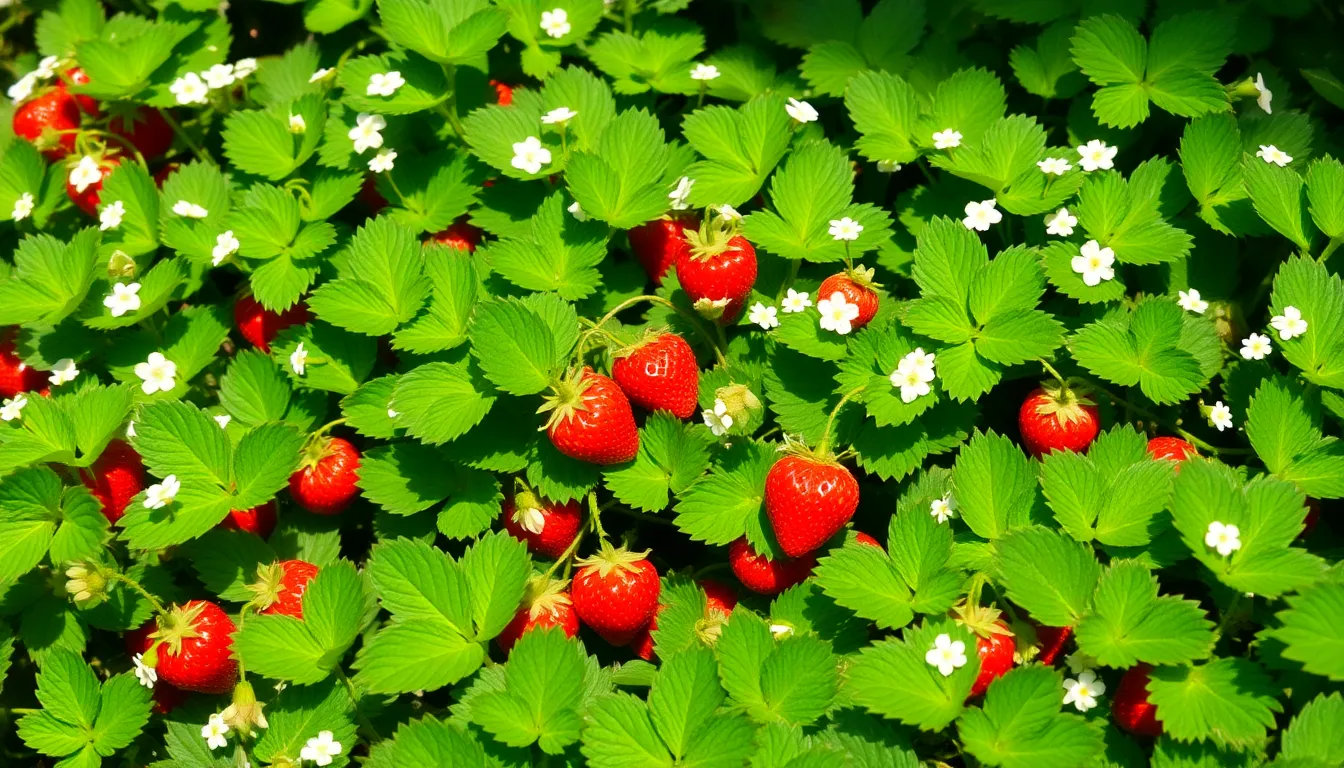
Wild strawberry offers a unique combination of ground coverage and edible benefits that sets it apart from purely ornamental options. This native perennial creates dense colonies through its spreading runners while providing sweet treats for both wildlife and gardeners.
Fruit Production and Harvesting Tips
Flowering occurs in early spring from April to May, producing small white blooms that attract bees and butterflies to your sunny ground cover areas. We recommend maintaining moist but well-drained soil conditions to support healthy fruit development throughout the growing season.
Harvesting takes place from May through August, though the berries remain much smaller than commercial varieties. These tiny fruits pack intense sweetness that makes them perfect for snacking directly from the plant or adding to salads and desserts.
Watering becomes essential during hot summer months to ensure consistent fruit production and plant health. We suggest applying water deeply but infrequently to encourage strong root development in your edible ground cover.
Winter protection helps maintain plant vigor for the following year’s harvest. Mulching with leaves or organic matter protects the crowns during cold seasons and supports better fruit production when spring returns.
Distinguishing from Traditional Strawberry Plants
Size differences make wild strawberry immediately recognizable compared to garden varieties. While cultivated strawberries produce large, commercial-sized berries, wild strawberry fruits typically measure less than half an inch in diameter.
Growth habits vary significantly between these two strawberry types. Traditional strawberry plants focus energy on fruit production and require regular replacement, while wild strawberry spreads aggressively through runners to form permanent ground cover colonies.
Disease resistance gives wild strawberry a major advantage over cultivated varieties in ground cover applications. We’ve observed that this native species shows much less susceptibility to foliar diseases that commonly affect traditional strawberry plants.
Ecological benefits distinguish wild strawberry as a superior choice for sustainable landscaping. This native plant supports local wildlife populations, attracts native pollinators, and helps suppress invasive species while traditional varieties offer minimal ecological value.
Maintenance requirements remain minimal for wild strawberry compared to high-maintenance garden strawberries. Traditional varieties need regular fertilization, pest management, and annual replanting, while wild strawberry thrives with basic care once established in sunny locations.
Install Moss Phlox for Rock Gardens and Borders
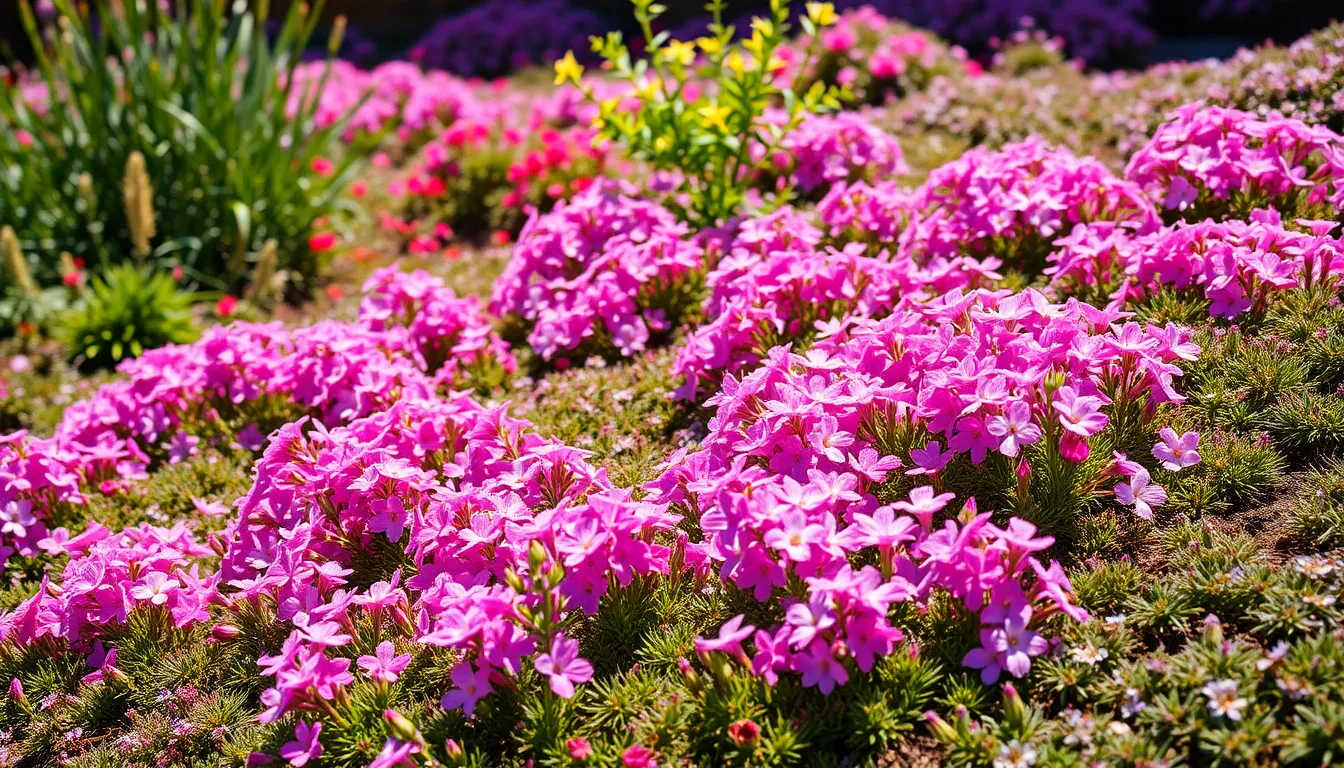
Moss phlox transforms rocky terrain and garden borders into vibrant displays of spring color through its dense, mat-forming growth habit. We recommend this exceptional ground cover for full sun locations where well-drained soil conditions exist naturally.
Creating Colorful Carpet Effects
Dense flowering mats emerge from moss phlox plantings, creating spectacular carpet displays that spread widely across sunny garden areas. This plant forms thick coverage that blooms profusely in spring, offering vibrant colors that transform sparse industry zones into eye-catching focal points.
Stonecrop varieties complement moss phlox perfectly, providing heat and drought tolerance while delivering seasonal blooms in varying colors throughout the growing season. We’ve observed these succulent ground covers improving visual appeal with their ability to thrive in harsh sunny conditions where other plants struggle.
Blue star creeper adds another dimension to colorful carpet designs, producing dense mats with delicate blue flowers that tolerate sun to partial sun conditions. This versatile plant handles light foot traffic while effectively suppressing weeds, making it ideal for pathways and border edges.
Multi-season interest develops when we combine these carpet-forming plants, as flowers extend from spring through summer and sometimes into fall. The extended blooming periods ensure continuous color rotation, keeping garden displays vibrant throughout the growing season.
Companion Plants for Enhanced Displays
Creeping thyme pairs beautifully with moss phlox in sunny locations, broadening the color palette while adding fragrant foliage that releases pleasant scents when brushed against. These companion plantings share similar sun and moisture requirements, creating harmonious garden beds with minimal maintenance needs.
Dianthus selections intensify garden displays by providing complementary textures and additional flowering periods that extend beyond moss phlox’s spring bloom time. We recommend choosing drought-tolerant dianthus varieties that thrive in the same well-drained soil conditions preferred by moss phlox.
Drought-tolerant sedums complete the companion plant trio, offering succulent foliage and late-season blooms that maintain interest after spring flowers fade. These plants collectively provide excellent coverage while reducing soil erosion and suppressing weed growth in sunny garden settings.
Continuous bloom succession results from strategic companion planting, ensuring garden displays maintain color and visual interest throughout multiple seasons. The combined plantings create sustainable landscapes that require less water once established, making them ideal choices for low-maintenance sunny gardens.
Conclusion
We’ve explored an impressive range of ground cover options that’ll transform your sunny spaces into stunning low-maintenance landscapes. From the vibrant blooms of creeping phlox to the drought-resistant beauty of sedums each plant offers unique benefits for your exact needs.
The key to success lies in matching the right plant to your site conditions and maintenance preferences. Whether you’re stabilizing slopes with Vinca minor or creating fragrant pathways with creeping thyme these hardy perennials will reward you with years of beauty.
Remember that proper soil preparation and initial care during establishment will set your ground covers up for long-term success. With minimal ongoing maintenance you’ll enjoy weed-free colorful carpets that enhance your outdoor spaces while supporting local wildlife and pollinators.
Frequently Asked Questions
What are the best ground cover plants for full sun areas?
The top sun-loving ground covers include creeping phlox for spectacular spring blooms, sedum for drought tolerance, creeping thyme for fragrant walkable coverage, and Ajuga for fast-growing weed suppression. Ice plants excel in extreme heat, while moss phlox creates vibrant carpet effects in rocky areas.
How much water do sun ground covers need once established?
Most sun ground covers become drought-tolerant once established, requiring minimal watering. Creeping phlox needs only 1 inch per week, sedum requires very little water, and thyme becomes highly drought-resistant. Deep watering during hot months benefits fruit-producing varieties like wild strawberry.
Can I walk on ground cover plants?
Creeping thyme is excellent for light to moderate foot traffic and releases a delightful herbal scent when stepped on. However, heavy traffic can damage the plants. Most other ground covers like creeping phlox and sedum are not designed for regular foot traffic.
How do I prevent aggressive ground covers from spreading too much?
Monitor spreading varieties like Ajuga and Vinca minor regularly. Use physical barriers or edging to contain growth, divide plants every 2-3 years, and prune regularly. Strategic placement away from native plant areas helps protect local ecosystems while maintaining the benefits.
What soil conditions do sunny ground covers prefer?
Most sun-loving ground covers thrive in well-draining soil with pH between 6.0-8.0. Poor drainage can harm these plants, so ensure proper soil preparation. Sedum and ice plants are particularly tolerant of poor soils, while thyme and creeping phlox prefer moderately fertile, well-drained conditions.
When do sun ground covers bloom and for how long?
Creeping phlox blooms spectacularly in spring, moss phlox creates vibrant spring displays, and ice plants produce brilliant summer flowers. Thyme varieties offer continuous blooms throughout the growing season. Combining different varieties ensures extended flowering periods and multi-season interest.
How far apart should I plant ground cover for quick coverage?
Plant thyme varieties 6-12 inches apart for quick coverage. Most ground covers should be spaced according to their mature spread – typically 12-18 inches apart. Closer spacing provides faster coverage but may require more initial investment and eventual thinning.
Do sun ground covers attract pollinators?
Yes, many sun ground covers are excellent for pollinators. Thyme varieties attract bees and butterflies with their abundant flowers, ice plants draw pollinators with vibrant blooms, and Ajuga’s blue flower spikes are particularly attractive to beneficial insects, supporting garden ecosystem health.

